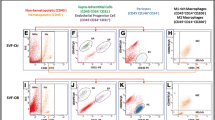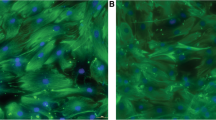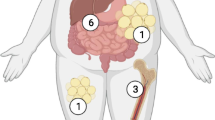Abstract
Background
Adipose tissue dysfunction is an important feature of obesity characterized by enlarged adipocytes and marked changes in secretion of cytokines. These changes result in insulin resistance, chronic vascular inflammation, oxidative stress, and activation of the renin–angiotensin system (RAS), eventually leading to type 2 diabetes, obesity-related hypertension, and cardiovascular disease (CVD). Several trials have shown that bariatric surgery significantly reduces these comorbidities. However, there is a gap in knowledge regarding the mechanisms whereby bariatric surgery reduces the burden of CVD in obese individuals.
Method
Mesenchymal stem cells (MSCs) were isolated from adipose tissue collected from three groups: (1) nonobese control subjects, (2) obese subjects undergoing gastric bypass surgery (GBS), and (3) subjects 1 year or more after GBS. In the study, MSCs were induced to adipogenic differentiation, and RAS-related gene expressions were determined by quantitative polymerase chain reaction. The effect of angiotensin II (Ang II) on adipogenic differentiation of MSCs also was investigated.
Results
Angiotensinogen mRNA levels in MSCs and differentiated adipocytes were significantly higher in the obese group than in the nonobese control subjects. Renin mRNA levels were significantly higher in the obese group MSCs than in the nonobese and post-GBS groups. Angiotensin-converting enzyme mRNA levels were significantly lower in the MSCs derived from the post-GBS group than in the obese and nonobese control subjects. Serum Ang II levels were significantly lower in the post-GBS group (52.1 ± 4.2 pg/ml) than in the nonobese (85.4 ± 12.4 pg/ml) and obese (84.7 ± 10.0 pg/ml) groups. Ang II treatment inhibited adipogenesis of MSCs in a dose-dependent manner. The inhibitory effect of Ang II was mainly abolished by PD123319, a receptor 2 blocker.
Conclusions
The adipogenesis of MSCs is inhibited by Ang II treatment. Obese individuals are characterized by an upregulation of the RAS-related gene expressions in adipose tissue. This upregulation resolves in post-GBS subjects.




Similar content being viewed by others
References
Lavie CJ, Milani RV, Ventura HO (2009) Obesity and cardiovascular disease: risk factor, paradox, and impact of weight loss. J Am Coll Cardiol 53:1925–1932
Poulos SP, Hausman DB, Hausman GJ (2010) The development and endocrine functions of adipose tissue. Mol Cell Endocrinol 323:20–34
Hajer GR, van Haeften TW, Visseren FL (2008) Adipose tissue dysfunction in obesity, diabetes, and vascular diseases. Eur Heart J 29:2959–2971
Paul M, Poyan Mehr A, Kreutz R (2006) Physiology of local renin–angiotensin systems. Physiol Rev 86:747–803
Atlas SA (2007) The renin–angiotensin aldosterone system: pathophysiological role and pharmacologic inhibition. J Manag Care Pharm 13:9–20
Thatcher S, Yiannikouris F, Gupte M, Cassis L (2009) The adipose renin–angiotensin system: role in cardiovascular disease. Mol Cell Endocrinol 302:111–117
Goossens GH, Blaak EE, Arner P, Saris WH, van Baak MA (2007) Angiotensin II: a hormone that affects lipid metabolism in adipose tissue. Int J Obes Lond 31:382–384
Skurk T, Hauner H (2004) Obesity and impaired fibrinolysis: role of adipose production of plasminogen activator inhibitor-1. Int J Obes Relat Metab Disord 28:1357–1364
Vaughan DE (2011) PAI-1 antagonists: the promise and the peril. Trans Am Clin Climatol Assoc 122:312–325
Goossens GH, Jocken JW, Blaak EE, Schiffers PM, Saris WH, van Baak MA (2007) Endocrine role of the renin–angiotensin system in human adipose tissue and muscle: effect of beta-adrenergic stimulation. Hypertension 49:542–547
Schorr U, Blaschke K, Turan S, Distler A, Sharma AM (1998) Relationship between angiotensinogen, leptin, and blood pressure levels in young normotensive men. J Hypertens 16:1475–1480
Jandeleit-Dahm KA, Tikellis C, Reid CM, Johnston CI, Cooper ME (2005) Why blockade of the renin–angiotensin system reduces the incidence of new-onset diabetes. J Hypertens 23:463–473
Engeli S, Bohnke J, Gorzelniak K, Janke J, Schling P, Bader M, Luft FC, Sharma AM (2005) Weight loss and the renin–angiotensin–aldosterone system. Hypertension 45:356–362
Torquati A, Wright K, Melvin W, Richards W (2007) Effect of gastric bypass operation on Framingham and actual risk of cardiovascular events in class II to III obesity. J Am Coll Surg 204:776–782 (discussion 782–773)
Heneghan HM, Meron-Eldar S, Brethauer SA, Schauer PR, Young JB (2011) Effect of bariatric surgery on cardiovascular risk profile. Am J Cardiol 108:1499–1507
Matthews DR, Hosker JP, Rudenski AS, Naylor BA, Treacher DF, Turner RC (1985) Homeostasis model assessment: insulin resistance and beta-cell function from fasting plasma glucose and insulin concentrations in man. Diabetologia 28:412–419
DeLany JP, Floyd ZE, Zvonic S, Smith A, Gravois A, Reiners E, Wu X, Kilroy G, Lefevre M, Gimble JM (2005) Proteomic analysis of primary cultures of human adipose-derived stem cells: modulation by adipogenesis. Mol Cell Proteomics 4:731–740
Janke J, Engeli S, Gorzelniak K, Luft FC, Sharma AM (2002) Mature adipocytes inhibit in vitro differentiation of human preadipocytes via angiotensin type 1 receptors. Diabetes 51:1699–1707
Benson SC, Pershadsingh HA, Ho CI, Chittiboyina A, Desai P, Pravenec M, Qi N, Wang J, Avery MA, Kurtz TW (2004) Identification of telmisartan as a unique angiotensin II receptor antagonist with selective PPARgamma-modulating activity. Hypertension 43:993–1002
Lane MD, Tang QQ (2005) From multipotent stem cell to adipocyte. Birth Defects Res A Clin Mol Teratol 73:476–477
Hotamisligil GS, Spiegelman BM (1994) Tumor necrosis factor alpha: a key component of the obesity–diabetes link. Diabetes 43:1271–1278
Danforth E Jr (2000) Failure of adipocyte differentiation causes type II diabetes mellitus? Nat Genet 26:13
Ravussin E, Smith SR (2002) Increased fat intake, impaired fat oxidation, and failure of fat cell proliferation result in ectopic fat storage, insulin resistance, and type 2 diabetes mellitus. Ann N Y Acad Sci 967:363–378
Matsushita K, Wu Y, Okamoto Y, Pratt RE, Dzau VJ (2006) Local renin–angiotensin expression regulates human mesenchymal stem cell differentiation to adipocytes. Hypertension 48:1095–1102
Saint-Marc P, Kozak LP, Ailhaud G, Darimont C, Negrel R (2001) Angiotensin II as a trophic factor of white adipose tissue: stimulation of adipose cell formation. Endocrinology 142:487–492
Rocchini AP (2002) Obesity hypertension. Am J Hypertens 15:50S–52S
Dallal RM, Hatalski A, Trang A, Chernoff A (2011) Longitudinal analysis of cardiovascular parameters after gastric bypass surgery. Surg Obes Relat Dis. doi:10.1016/j.soard.2011.09.020
Acknowledgments
The study was supported by a SAGES Research Grant Award and an NIH K23 DK07597 award to A.T. The authors thank all the participants in this study.
Disclosures
Jie-Gen Chen, Anna Spagnoli, and Alfonso Torquati have no conflicts of interest or financial ties to disclose.
Author information
Authors and Affiliations
Corresponding author
Rights and permissions
About this article
Cite this article
Chen, JG., Spagnoli, A. & Torquati, A. Adipogenic differentiation of adipose tissue-derived human mesenchymal stem cells: effect of gastric bypass surgery. Surg Endosc 26, 3449–3456 (2012). https://doi.org/10.1007/s00464-012-2353-x
Received:
Accepted:
Published:
Issue Date:
DOI: https://doi.org/10.1007/s00464-012-2353-x




